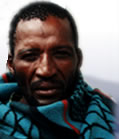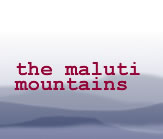 |
 |
||
 |
|||
|
RELATED THEMES agriculture economics environment justice and crime land OTHER LOCAL THEMES BACKGROUND |
livestock
The livestock owned in this area are cattle, sheep, goats, horses and donkeys, and are regarded as an important form of wealth, which can be sold for cash at times of need. Sheep provide wool and mohair, cattle assist with ploughing, horses are used as a means of transport and donkeys are used to carry things. Residents claim that because of the quality of the letsiri grass on which they graze, cattle in the area live longer than lowland cattle and the cows calve up to seven times, compared with four times in the lowlands. People are very concerned about what will happen to their livestock when they relocate and whether they will have access to pasture. Some have chosen to move to other villages in the mountains, rather than to the lowlands, so that they can keep their animals. Villagers have always employed rotational grazing patterns to avoid over-exploitation of any one pasture. In recent seasons, the principal chief banned people from taking their livestock to fertile land higher up the mountains as early as they usually do; this resulted in overgrazing of areas closer to the village and consequent soil erosion. As pasture has decreased, due to expansion of fields as well as the new restrictions, people's herds have reduced. Recently, animal theft has become a problem, too. Thieves come by the new road from outside the area and have modern weapons whereas the villagers only have sticks. And some of the more well-off are already selling off animals, turning livestock wealth into something they can take with them when they relocate. Several testimonies describe how some time ago the military government of Major General Metsing Lekhanya imposed a policy to kill all "black" sheep. People had to slaughter some of their stock in order to comply. It appears they didn't understand the reasoning behind the policy - which suggests poor communication - and that they found that those who imposed the ban didn't actually follow it themselves. But ultimately, there were different priorities: the government was interested in improving the quality of Lesotho's sheep and in culling less good stock; the people were interested in maintaining the quantity of their animals. Several men (and one woman) recall their days looking after their own and other families' livestock throughout the year, from as young as nine. One elderly man describes in detail his days as a herd boy (Lesotho 7). They were generally given one cow or several "short" animals (small livestock) per year in return for their work, in addition to milk throughout the year. Those who could afford it or who had no sons sometimes hired herd boys from other families. quotes about livestock
"An animal of the lowlands gets old while it is still young, it becomes without teeth. You would even say it is old whereas it is not; it is [just] that its teeth have been taken out by this molula (type of grass).. A cow of here [which grazes on letsiri grass], when it does not have teeth you should know that it is because of its old age, not that its teeth have been worn out by grass." "[In the lowlands].a cow [stops calving after] four calves but ours here [calve] seven [times]." "During our growing up, that is myself and those I grew up with, we were herd boys. In our so herding livestock, we used to milk the cows in the pastureland during the day and we drunk the milk. We would simply suck them (the cows) as they went about. Besides this, I think indeed that our other activities included digging out edible roots of some wild plants such as montsokoane, tsoetta, and mputsoe. In this way we keep living fairly well or even by eating monakalali. Apart from this, we would mould clay cattle. As boys, we would also stay at the cattle post since we indeed were unable because of our looking after the livestock to receive any proper schooling as such." "[livestock kept in large numbers?] Those are sheep and goats because one is able to sell wool and mohair annually and also because they are able to increase in numbers quicker than other livestock. This is so because both kinds breed twice a year. Cattle are also of great importance because they are used to plough." |
|